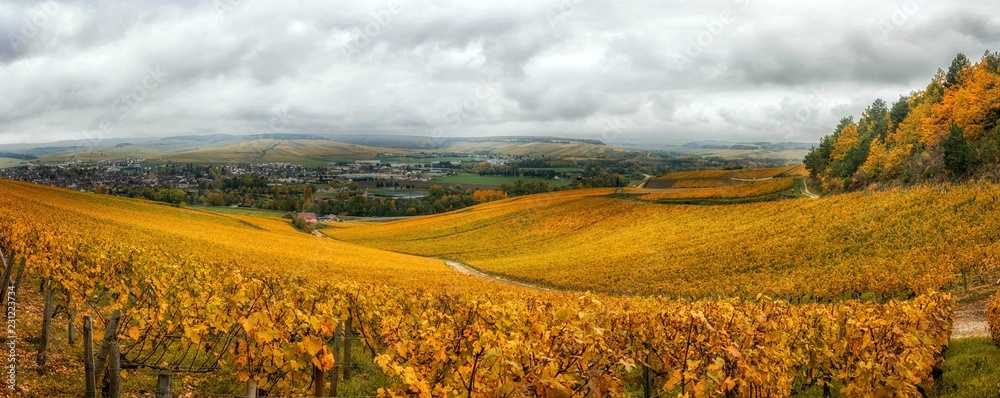 |
| Chablis vineyards in Autumn/Adobe image |
To oak or not to oak? That's the question that has been troubling Chablis producers since the end of the 19th century.
While most fine white Burgundies, made from Chardonnay, are fermented and aged in oak, the question of oak contact in Chablis, also made from Chardonnay, is up to the individual winery. Many things are certain in Chablis, but not the use of oak.
The use of oak is not the only difference between the two wines. Chablis and the Cote de Beaune, a part of southern Cote d'Or, are separated by geography. Chablis is the most northern part of Burgundy, more than 60 miles to the northeast of Cote d'Or, closer to Champagne than Burgundy. This odd arrangement goes back to the 15th century when Chablis became part of the Duchy of Burgundy.
Thus, geography places Chablis far from the equator, subject to the variable and uncertain effects of a northern continental climate, and the threat of Spring frosts. Weather variables have a major impact on grape quality and harvest quantity.
The Chablis Commission says that vineyard production has reached maximum and that growers are dealing with challenging problems like bad weather in 2024 that resulted in very low wine production.
Wine making under these conditions, in both Chablis and Cote d'Or, is reflected in the character of the wines. Unoaked Chardonnay from Chablis is crisp and mineral, while the Cote de Beaune Chardonnay is fuller, with spice from time spent in oak.
Oaked Chablis becomes a different wine, while still reflecting its terroir. And in Chablis, as it is everywhere in France, vineyard terroir is everything.
Chablis winemakers wanting to retain a mineral characteristic, known locally as gout to pierre à fusil (the taste of gunflint), prefer stainless steel fermentation. Other winemakers, favoring the use of oak, like the extra dimension, provided by oak, in the wine's taste and structure.
Quality levels for Chablis are based on vineyards. Within each of the four levels, there are specific vineyards, often mentioned on the label. At the top are Grand Cru Chablis are seven named vineyards, including Les Clos and Valdesir. Next are Premier Cru Chablis from 79 named vineyards.

The two lowest levels, Chablis and Petit Chablis, vie for authenticity and quality. Those wines labeled Chablis are from anywhere in the appellation, whereas Petit Chablis are made from lesser vineyards or plots.
Officially, Petit Chablis wines are rated lower in quality, but lately some producers have been more selective about vineyards and wine making, thus the positioning may be shifting.
Petit Chablis is selling well in the United States, helping to make the U.S. the top market for all Chablis. The market is seeing rising prices for all Burgundy, causing astute shoppers to see Petit Chablis as Burgundian Chardonnay at a more reasonable price.
Prices for Burgundy, including Chablis, are all over the board: Puligny-Montrachet, $120 to $300+; Chablis Grand Cru, $120 to $200+; Chablis Premier Cru, $35 to $50; Petit Chablis, $25; Chablis, $15 to $30.
There will always be a demand for great Chardonnay, whether it be from the Cote de Beaune, Chablis, California or Australia. With steadily rising prices, now may be a good time to look at Chablis.
Next post: The Value of Aging Wine
Leave a comment at boydvino707@gmail.com



No comments:
Post a Comment
Note: Only a member of this blog may post a comment.